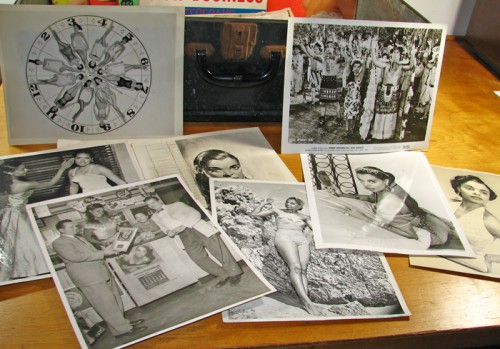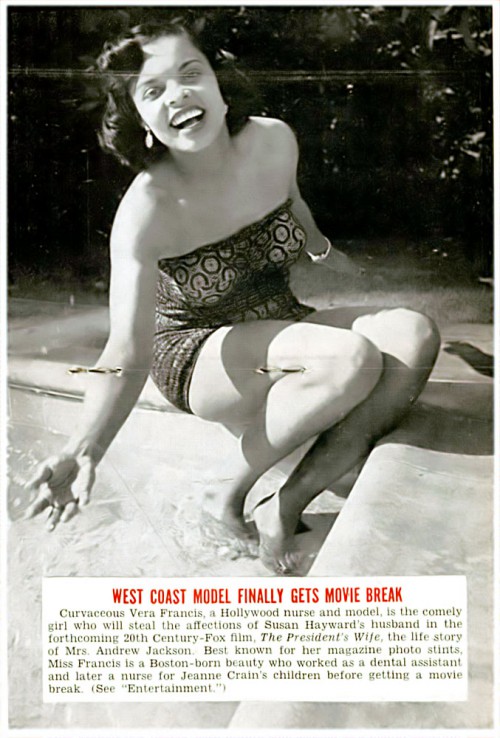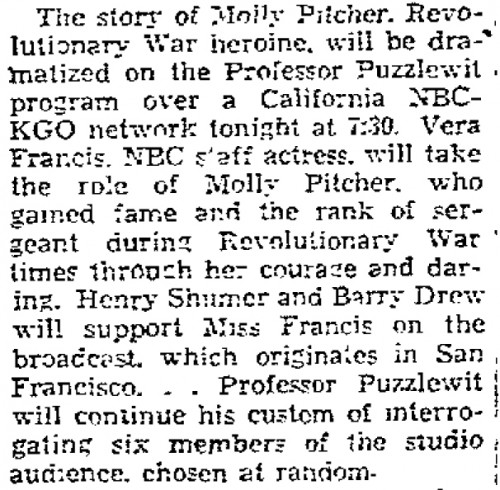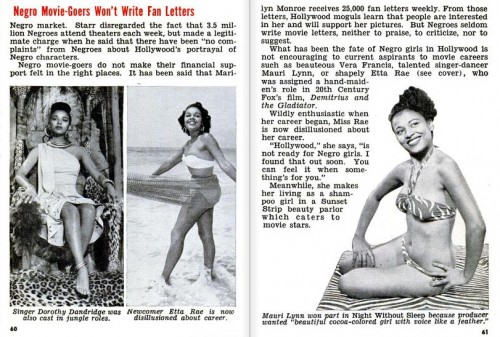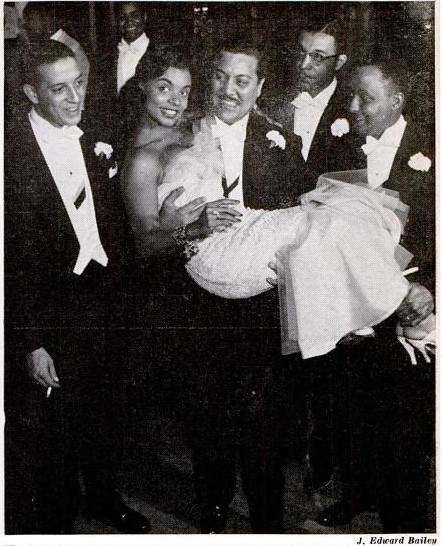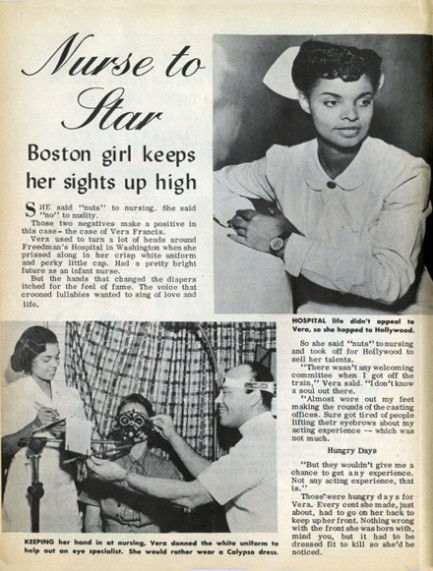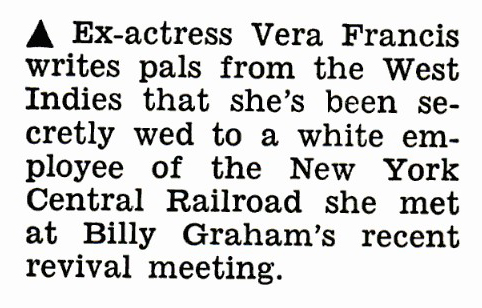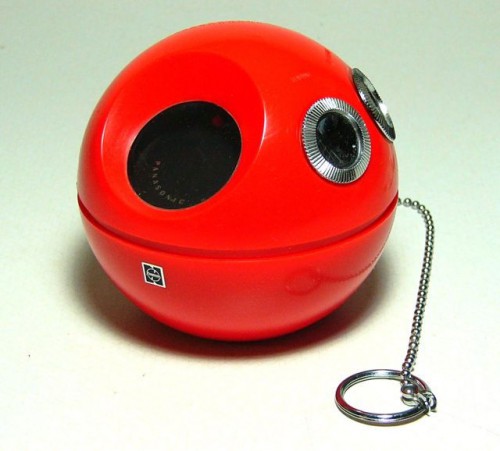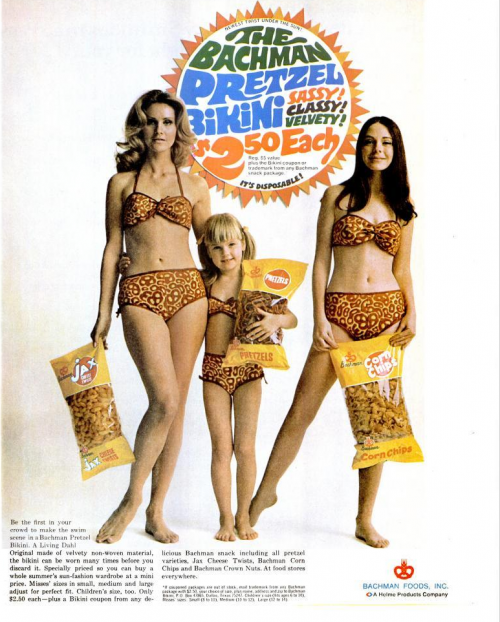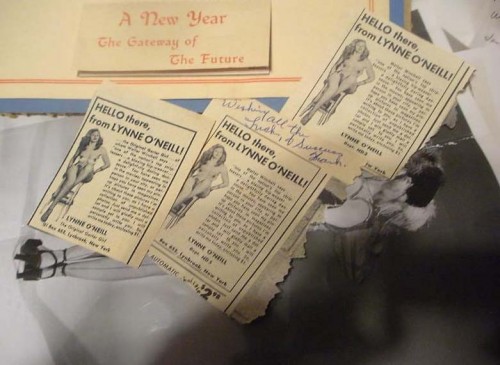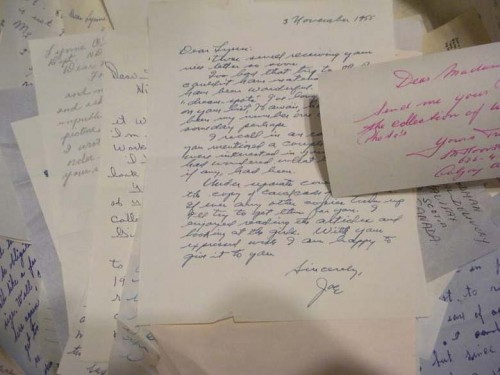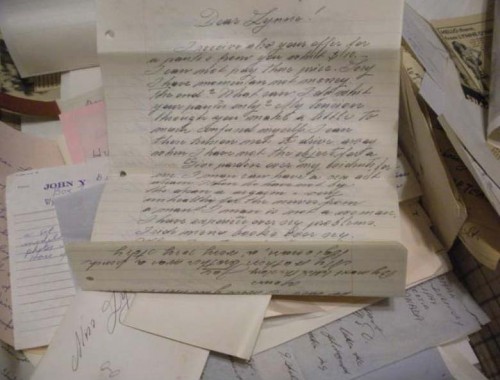A 1929 art deco advertising sign for Venus Wholesale Oil Company, Geneva, Nebraska; via.
Tag: vintage advertising
What Every Young Girl Should Know
Boys like girls who make Seven-Up “Floats”
What every young girl should know is this: Nobody can resist a 7-Up “Float”! Want to see? Put a scoop of his favorite ice cream of sherbet in a tall glass. Tilt the glass, and pour chilled, sparking 7-Up gently down the side. The fresh, clean taste of 7-Up works a special magic with ice cream. And don’t forget a 7-Up “Float” for yourself! P.S. Boys like 7-Up — girls like 7-Up — for regular thirst-quenching, too. Take home a case of 7-Up so you’ll have plenty on hand. You like…it likes you!
Hey, look, it may be sexist, but it also tells girls how to avoid giving boys head — on their 7-Up “Floats” (forever in quotes) and later, their beers.
Copyright 1960 by the Seven-Up Company; via.
Fashion Forecasting With Tarot Cards (In 1953)
A fashion spread in Harper’s Bazaar, August 1953, featuring over-sized tarot cards. Photos by Louise Dahl-Wolfe.
Whatjamacallit Wednesday: How Do You Get Kitten Hips? And Why Would You Want Them?
Kitten hips. No, not the furry kind — the “lithe young American” kind, as described in this vintage girdle ad published in Harper’s Bazaar, 1946.
You feel and look as if you’d just stepped out of a success course when you step into Carter’s “Mouldette.” The entire beautifully molded back is made with new synthetic elastic. Carter’s own Sweetheart panel flattens the tummy. Every seam’s a scheme to give you that lithe young American look.
You can find these ads on eBay.
Spin The Wheel, Land On Vera Francis
Who wouldn’t fall in love with a vintage roulette wheel of pinups?
The seller (Grapefruit Moon Gallery), says this in the item’s description (links added by me):
ITEM: You are bidding on a very rare vintage pin up photograph of African American 1955 Hollywood sensation, and later boulevard of broken dreams archetype Vera Francis and a number of other showgirls as a proverbial roulette wheel where every spin is a winner. Measures 8″ x 10″
We are happy to be offering examples from the archives of Vera Francis, who was called a Hollywood Tragedy after being blacklisted from the screen for allegedly selling stories to the scandalous tabloid Confidential, about the inappropriate behavior of her often white co-stars and superiors. But the real tragedy of her career is that despite appearing in movies throughout the early 50s and being splashed upon magazine covers (Jet and Ebony notably) for her breakthrough role in “The President’s Lady” a story about the interracial affairs of American president Andrew Jackson, her name isn’t even featured in imdb for many of her known parts. The combination of her outspoken role in civil rights (Lena Horne was her oft mentioned hero), her “loose talk” and the scarcity of roles for black actresses in the 1950s meant that she disappeared quickly from the scene. However, she retained a lot of her allure in African American theater communities, performing in touring productions throughout the 1950s and 1960s and appearing in cabarets and as a model and pitch woman.
I was intrigued…
According to the San Mateo Times (September 30, 1954), the photo isn’t a true movie still, but promotional photo for MGM’s film, The Prodigal, sent out on the AP.
Researchers working on “The Prodigal” discovered that beautiful girls were the stakes in a gambling game popular in ancient Damascus of about 70 B.C., and so this wheel of feminine fortune was incorporated in the movie now being made at M-G-M. The girls will wear Damascus costumes in the movie, but for this photo the studio dressed the beauties in modern swim suits. The girls, all from Southern California and all making their movie debuts are: (1) Nancy Chudacoff, (2) Alice Arzaumanian, (3) Jolene Burkin, (4) Bobbie White, (Barbara White, (6) Aen-Ling Chow, (7) Marion Ross, (8) Patrizia Magurao, (9) Marjory May, (10) Vera Francis, (11) Jeanette Miller, and (12) Sheela Fenton.
But who was Vera Francis?
In the Encyclopedia of African American Business: Volume 2, K-Z, Vera is a single line entry, listed among the “pioneer models” which drove the development of the Barbara Watson Charm and Model School. In Style and Status: Selling Beauty to African American Women, 1920-1975, she’s merely a “Los Angeles model” quoted along with a few other models quelling the fears of middle-class magazine readers, of the non-white variety, that “the image of models as reckless party girls with loose morals was much exaggerated.” Vera’s comment was “I always keep a regular job, it’s one sure way of staying out of trouble.”
What were Vera’s “regular” jobs? According to the September 25, 1952 issue of Jet magazine, which contains a profile of the young starlet, “Curvaceous Vera Francis, a Hollywood nurse and model, is the comely girl who will steal the affections of Susan Hayward’s husband in the forthcoming 20th Century-Fox film, The President’s Wife the life story of Mrs. Andrew Jackson. Best known for her magazine photo stints, Miss Francis is a Boston-born beauty who worked as a dental assistant and later a nurse for Jeanne Crain‘s children before getting a movie break.”
But sadly, there’s not much more known about Vera — despite the fact that, at least since 1952, Vera Francis was a staple on the covers (and pages between) of Jet, Hue, Sepia and other magazines for persons of color.
So, you know me, I obsessively set about researching Vera Francis, trying to create a biography…
However, I can’t honestly call this a biography; it’s more of a Vera Francs timeline at this point as most of what little (too little) I found is centered on gossip and one-line bits of info. However, given that Vera was a starlet, one can’t entirely ignore the gossip; that’s the only way one really finds more photos. In the Jet pages especially, you’ll see that Vera’s “loose talk” was probably based on some pretty hot action — along with movie talk and other gigs, there was plenty of gossip to rival the starlet’s “staying out of trouble.” Clearly, Vera was out and about, making the scene, hoping to make it in Hollywood.
[If you take these images to post elsewhere, please credit me with a link — I spent more hours than you want to know researching, scanning, cropping, editing this!]
The Vera Francis Timeline
The Daily Gleaner, Jamaica, April 11, 1935, Vera and Beryl Berth were arrested by Detective Hutchinson on a charge of selling ganja.
The Daily Gleaner, June 1, 1935, Vera Francis was “fined five pounds or two months hard labor for a breach of the Dangerous Drugs Law, to wit, selling ganja.” (No mention of Beryl.)
The Daily Gleaner, July 27, 1936, Miss Vera Francis is mentioned in a recital and is listed as being from Boston, U.S.A.
Oakland Tribune, July 13, 1937, Vera was mentioned as an NBC staff actress to take on the roll of Molly Pitcher on the Professor Puzzlewit program.
Jet, September 25, 1952: Announcing Vera’s role in the interracial romance film The President’s Lady.
Jet, October 16, 1952: Featured in “Why Brownskin Girls Get The Best Movie Roles.”
Jet, September 25, 1952: In press about The President’s Lady, a studio spokesman says, “When Lena Horne retires, Vera Francis will take her place.”
Jet, February 19, 1953: Photo caption reads:
Rock-A-Bye Baby: Midget liquor salesman Frankie Dee proved a real attention-getter when he turned up at New York City’s Beaux Arts ball in diaper attire. Actress-model Vera Francis and actor Jimmy Edwards made it a family threesome by obliging “baby” Frankie with his bottle.
Jet, April 16, 1953: when returning to Hollywood, “received offers as high as $100 for her address book that contains names of New York’s bachelors.” (Foreshadowing of the Confidential scandal?)
Jet, August 27, 1953: A guest at a birthday party for Lucky Millinger — Millinder is fed cake by “hi-de-ho” bandleader Cab Calloway while Francis and others look on.
Jet, September 10, 1953: Vera Francis crowns Betty Elaine Parks “Miss America” in an Elks Beauty Contest in Atlanta.
Jet, Sepembert 17, 1953: The actress is featured in the article “Why Hollywood Won’t Glamorize Negro Girls.”
Jet, October 8, 1953: Talking About “Exotic Vera Francis who does public relations work for a national cosmetics account. She was assigned to demonstrate the beauty products in an Atlanta five and ten, but when the store managers, who had asked for her, discovered that the movie starlet’s features were brown, they quickly called off the deal.”
Jet, November 26, 1953: “Movie actress Vera Francis lost her job as assistant to disc jockey Jack Walker. He fired her for not having ‘humility’.”
Jet, May 6, 1954: At the Shalimar Cafe party for disc jockey Tommy Smalls “Joe Louis is fed by Delores Parker, Vera Francis.”
Jet, May 13, 1954: Caption for the photo reads Elephant Girl: Turning out for the spring arrival of Ringling Brothers, Barnum and Baily Circus in New York, film actress Vera Francis and comedian Nipsey Russell visit with a friendly elephant named Ruth. Vera climbed aboard but Russell played it safe on the ground.
Jet, April 22, 1954: The actress has “midgets” Frankie Dee and Pee Wee Marquette fighting over her.
Jet, June 17, 1954: Caption for the photo reads “Cotillion Capers: A guest at the Cotillion Club’s annual deb ball in Detriot’s Graystone Ballroom, movie star Vera Francis gets an affectionate lift by admiring club members. Curvacious Vera recently embarked on a new career as a calypso-style song and dance entertainer.”
Jet, June 24, 1954: Poses for amateur photographers.
Jet, July 22, 1954: Sheesh — “Mose Thompson, the Detroit financier, who invited movie starlet Vera Francis to town for a little light balling only to have her snatched from his fingertips by dapper cigar huckster Sterling Hogan.”
Jet, Augus 19, 1954: Vera Francis and Juanita Moore, signed to portray women inmates in Columbia’s Women’s Prison.
Hue, August, 1954: Vera Francis photographed at the Surf Club “Puckered Up for Kissing”.
Jet, September 2, 1954: Said to play role of a jungle girl in the next series of Tarzan pictures.
Jet, September 30, 1954: Said she signs for a feature role as one of 12 international beauties in MGM’s Biblical movie, The Prodigal to play a “maid of India.” (The roulette wheel that started all my obsessive hunting.)
Jet, December 2, 1954: “Now that she has had several minor roles in Hollywood films, shapely actress-model Vera Francis has changed her stage name to Vieja.”
Jet, December 16, 1954: A note that the “model-actress” to appear in Kiss Me Deadly (a Mickey Spillane feature) and Universal-International’s Tracey (starring Anne Baxter and Rock Hudson — near as I can tell, eventually titled One Desire).
Sepia, December 1954: Vera Francis on the cover and the subject of a feature story.
Jet, May 12, 1955: “Showgirl” Vera Francis adjusts Sammy Davis Jr.’s Windsor knot at the Harlem YMCA’s salute to Sammy.
The Gleaner, March 17, 1955: “Vera steals the show” in Kitty Kingston’s Personal Mention column. Vera is said here to be “of Indian as well as Jamaican origin” which “thrilled” party guests, especially “the ten Government employees of Pakistan on UNESCO Fellowship.” Here Vera’s new professional name, “Veijah” is mentioned and stated as meaning “victory.” The films Vera is to be gearing up for are listed as The Ten Commandments, Kismet, The White Witch of Rose Hall, and The Jungle Drums, to be filmed in Tunisia for Italian Films.
Also in that paper, an ad for Vera Francis appearing in person on the Carib Stage. (Note that Vera Francis is listed as “Jamaica’s Very Own” despite the paper saying in 1936 that she was from Boston.)
Jet, September 8, 1955: Francis “the movie bit player,” underwent a hernia operation at Cedars hospital, LA.
Jet, October 6, 1955: A note that Vera is rehearsing for a road company tour of the play Seven Year Itch. “She’ll wiggle her hips in the role that move actress Marilyn Monroe made famous.”
Lima News, August 24, 1957: In coverage of the Confidential libel scandal, Vera was named as paid informant regarding John Jacob Astor and Edward G. Robinson.
No details were offered. But, according to Shocking True Story: The Rise and Fall of Confidential, “America’s Most Scandalous Scandal Magazine”, “Vera Francis, a black actress, was paid for a story on her affair with socially prominent John Jacob Astor.” (I believe it was this John Jacob Astor — a family with enough scandal that whatever info Vera sold is a footnote too small for me to bother researching. At least right now.)
Jet, January 2 1958: Words fail, so I quote:
Ex-actress Vera Francis writes pals from the West Indies that she’s been secretly wed to a white employee of the New York Central Railroad she met at Billy Graham’s recent revival meeting.
Jet, May 15, 1958: “Former actress-model Vera Francis has turned “producer” in Jamaica, BWI. She presented her husband, George Handiwerk Jr., with a bouncing seven-pound, three-ounce daughter.”
The Gleaner, August 24, 1958: Mentions that Mrs. Vera Handwerk (the guest of Mr. and Mrs. Carby) is slated for the leading role in Calypso, to be filmed in Jamaica.
Jet, June 18, 1959: Vera “now Mrs. George Handwerk Jr. is four months again on her motherhood career, leaving behind in Kingston, Jamaica, her German husband to mind the first-born which she visits her sister.”
Jet, August 27, 1959: Vera Francis divorced “her white husband, George Handwerk,” married on September 8, 1957. They had a daughter, Francena, and Vera was pregnant with a second child.
Jet, January 14, 1960: “Pretty actress Vera (Francis) Handwerk gave birth to an eight-and-one-half pound girl, Janna, her second, in Jamaica, Britsh West Indies.” Here’s the photo that accompanied the news bit.
The Gleaner, November 26, 1961: Vera is listed as the hostess who also M.C’eed a fashion show at Babs Boutique.
But by September 1962, in Negro Digest (Black World), people were wondering where Vera Francis was.
The Gleaner, October 3, 1964: Vera is listed at the Bunny Mother for the Jamaican edition of the Playboy Bunnies.
Pontiac Daily Leader, February 12, 1969: She is mentioned as the “former Vera Francis” — now the Mrs. in Mr. and Mrs. Harlan Robertson. The couple, along with son Randy, were in Odell visiting Vera’s father, Perry Francis. No mention of the daughters.
Nowhere do I find any proof of Vera’s “outspoken role in civil rights”, though clearly she lived her life as a woman who resisted labels and limits — in terms of color and gender.
Additional image/info: In June of 2011, Bonhams auctioned off a lot of Vera Francis archives for $915.
Power Girdle
Watch Where You’re Putting That Coke Bottle, Bub
Product placement matters. Accident? Or subliminal phallic ad designed to make men and a few free-swingin’ women take immediate action?
The seller’s description:
[V]intage original 1950s double sided Coca-Cola – Coke soda fountain sign with its original aluminum frame. This is an outstanding antique original example the artwork is of course by Gil Elvgren, a pretty circus pin up girl performer on a trapeze with text that reads “Now! For Coke – Take Plenty of Coke Home”.
Spotting Memories In Retro Radio Ads
Still nostalgic thinking about the old days in Milwaukee radio, I’ve been hanging out consuming The Halcyon Daze (I prefer using the “classic” interface for navigation, in case you visit here, Scott Beddome — aka rock’s Scott “The Kid”). I’m particularly smitten with this post of 1984 TV commercials for radio — especially this classic WKTI spot:
Not only does it feature Reitman & Mueller, and the Booze Brothers — but that’s Warren Wiegratz on the keyboards!
Having stalked Oceans for years, I’d know. My Oceans following began in 1984 or so, when my biological sister’s foreign exchange “French sister,” Christine (Oh, so tempted to talk trash about Christine and her visit; but I will behave.), came to stay with us and she wanted to hear a jazz band. So my parents took her to Sardino’s. After an early crush on Duane Stuermer (somewhere around here I have signed ticket stubs from Duane, and, possibly, his brother Daryl), I eventually forged a friendship with drummer Ernie Adams — who’s dad, it turned out, worked with my mom. Small world. It became even cozier when Ernie and and dated; but I don’t like to kiss and tell. *wink*
Of Tailgators, Radio & Retail
This is a vintage WKTI Tailgator pinback from 1983, featuring Old Style beer. It’s mere 1.75 inches, but oh the size of the memories it unleashes…
If you’re of a certain age — and from the Milwaukee, Wisconsin, area — you remember this era of WKTI, Reitman & Mueller — and the uncomfortably named Jim “Lips” LaBelle.
Thinking of WKTI reminds me of the days our family ventured into the retail business. We bought into the Just Pants franchise, running the Just Pants store at Southridge Mall, then a Taubman Mall (Taubman married and divorced from Christie Brinkley, a rather too present icon of my life, helping me date nearly anything).
Our biggest Just Pants competitor was the County Seat — and Kohl’s department store (which bled we specialty jean stores to death by using Levi’s and Lee denim loss leader sales). Anyone else remember the days of denim walls so high, sales staff used ladders to reach the goods? That’s the pun behind this sexy Just Pants ad — it predates when we had our store (and I doubt we would have ran the ad ourselves, even if it had been in the creative pool of franchisee options.)
Anyway, in that era we not only often played WKTI in the store but we special ordered and custom hemmed Bob Reitman‘s black boot-cut Levi’s. Yeah, we were that cool.
Back then, we not only played whatever radio we wanted in the store, on July 13, 1985, we played the Live Aid broadcast in the store. I called in from the store to donate, getting myself an official Live Aid t-shirt. (They were out of my size, so I received a size small which wouldn’t have covered The Girls and so it has remained safely packed away all these years.)
Now, WKTI is WLWK, “Lake FM.” (Reitman’s still kicking it on air with his weekly show, It’s Alright, Ma, It’s Only Music.) And, ironically, Lake FM sounds almost like an auditory time capsule of the Reitman & Mueller days. I know, I’ve listened to the station when I’ve traveled home. Old habits die hard and my fingers still “dial” to the stations I recalled. Not that any of them are there anymore. Lazer 103, QFM, LPX… All long gone. Apparently, after I moved from Wisconsin, the radio station marketplace went to hell. I’m not the only one who’s more than nostalgic; check out 93QFM: The Halcyon Daze for Milwaukee Rock Radio DJ Stories.
This got me thinking about the other radio stations & DJs… And the connections to retail.
Marilynn Mee, aka Jackpot Girl, part of Bob And Brian’s morning show on Lazer 103 (Mee may still be on WKLH?), was someone I met quite often when I was working at the Estee Lauder counter at Gimbels. Mee was pals with Pam, who worked Lancome. I envied Mee her wardrobe of all things. But then, if you’ve ever had to wear the cosmetic girl garb, well, you’d understand it. Hard to feel 80-‘s glam when you’re wearing a turquoise smock-tent, no matter how fab your face and hair look. (Despite the fact that Marilynn and Pam partied with rock stars, I was the good girl who found herself knocked up; an entirely different subject, and I’ve digressed too much already.)
Because I’m all nostalgic about radio…
My first radio love was WOKY — and AM station that then played top 40 pop stuff. It came in loud and clear on my red ball Panasonic R-70 transistor radio.
I would turn the volume up and dance madly in the back yard. My most vivid memory is of cranking up Billy Preston’s Go Round in Circles and dancing on top of the old wooden picnic table. So not safe, I’m sure, even if you weren’t dancing yourself dizzy goin’ round in circles. Ahh, those were the days, though.
http://www.youtube.com/watch?v=un63LEAN22E&noredirect=1
Image Credits: Vintage 1970 Just Pants ad via Ads-Things4Less. Panasonic photo via ebyauctions.
Their Font Said “Soda Pop” But Their Photo Said Something Else
“For Extra Fun Take More Than One” I think they meant the packs of Coke, not women… Of course, I could be wrong; you know how compelling men find a set of twins. Sublimely subliminal. Via.
The Bachman Pretzel Bikini
Hey, edible underpants, you had competition… The Bachman Pretzel Bikini.
Just $2.50 for a “classy” and “sassy” two-piece bikini of “velvety non-woven material.” I can’t imagine you could swim in it. Nor can I imagine wanting a crunchy edible item of apparel — which the words “pretzel bikini” rather imply. Perhaps non-woven means edible? Plus the obvious “good enough to eat” cliche, which the pretzels then lend to the women, and kids, who wear it…
In any case, what’s the use of such a novelty item that “can be worn several times before you discard it”? Pure schtick promo, that’s definitely in bad taste no mater how you look at it.
Via this post at Found In Mom’s Basement.
Make Up For Breasts?
No offense to Mr. Vargas, but I think he misunderstood the task… This vintage ad was for “Twin Make Up,” not makeup for “the twins.”
The original artwork by Alberto Vargas goes up for sale at Heritage Auctions on September 30, 2011.
ALBERTO VARGAS (American, 1896-1982)
New Jergens Twin Make-Up, advertisement poster, 1943
Mixed media on board
18 x 14 in.
Signed upper left
Why Long Nails Are Sexy
Fingernails have long been symbols beauty — specifically as indicators of wealth. The cleaner, the longer, the more well-manicured, the more they distance the wearer from manual work. Long nails, even if natural fingernails, are unnatural — and the really long “dragon lady” fingernails are sexy because they are so removed from the norm they become exotic.
We may no longer be digging roots out of the ground, grinding corn by hand, or banging laundry against rocks; but (most of us) still wash dishes, scrub floors and type on keyboards — all which wreak havoc with our nails and manicures. And so, whether we “do less work,” pay for our manicures, or just wear gloves to protect our hands, manicures, and pretty hands in general, remain “beautiful” because they and/or the high maintenance of them indicate wealth.
Image credits: Chen-Yu Nail Polish for Vogue, 1939; photographer Horst P. Horst. Via.
Dreaming Of Denial
Suffragette Soap Ad
This ad, for sale from MAINE-ARTEMIS, shows how products were marketed to suffragettes.
Enoch Morgan’s Sons Company ad for Sapolio cake soap:
A suffragette is Mrs. Brown
Who’s cleaning up in Spotless Town
When she discovers wrongs to write
The mails assist her in the fight
De=voted readers high and low
Are voting for
Sapolio
What Are You, A Man Or A Monkee? Or, Worse Yet, Gay?
“There’s A Tremendous Difference Between A Pansy & A Chimpanzee” …But both use gasoline?
Vintage ad for Ethyl Gasoline, found in a 1950 Life Magazine; via GeriADtric.
What Time Is It?
According to this ad for Bulova watches, it’s time for a pajama party. Circa 1963; via Simple Dreams.
Yes We Can! Rosie The Riveter Fashions
Proof that this look was in fashion for women before there was an American home front and a The War Advertising Council’s Women in War Jobs campaign with Rosie the Riveter.
Scanned from New Fashions For You & Your Home, Spring Summer 1940, published by Singer Sewing Machine Company (I’ve listed it at eBay), this page features patterns by Du Barry.
More scans from this vintage publication at my Tumblr.
Trophies For Misogynists
Vintage ad for wall-mounted female human heads reads:
“Stuffed” Girl’s Heads! Only $2.98
Blondes, redheads and brunettes for every man to boast of his conquests…the first realistic likeness of the exciting women who play an important part in every man’s life…and one of the nicest qualities is that they don’t talk back! Accurately modelled to three-quarters life size of real galls and molded of skin-textured pliable plastic, these heads are so life-like they almost breathe. Saucy glittering eyes, full sensuous mouth and liquid satin complexion, combined with radiant hair colors give astonishing realism to these rare and unique Trophies. Blonds, redhead or brunette mounted on a genuine mahogany plaque is complete and ready to hand on the wall for excitement and conversation.
Not a lot leaves me speechless. But here I am.
Found at The Immaculate Consumption.
Retro Zolar Fortune Telling Materials
An ad for Zolar fortune telling cards and Ouji Genii Board found in Rance Romance & Adventures, May 1971.
Jester Wools, For Gayer Garments
Via the fabulous Chateau Thombeau, we find out just who robbed the rainbow to make us look gay — hey, why isn’t this guy in the Skittles ads? I bet he sounds just like the new Chester Cheeto.
Wax On, Wax Off
“Give Your Wife An Extra Head For Chirstmas”
An ad from 1969 that likely couldn’t be published today:
OK, so it reads “an extra head,” not just “extra head” or just plain old “head,” but still, ad execs today would just know what we’d be reading into the buzzing gift of a Lady Remington.
Lady Remingtons, by the way, were quite popular gifts, judging by the number of them found at garage sales, thrift stores, etc. So this ad may have sent just the right message after all. *wink*
It’s Like A Pucci In The Face
 If you have difficulty being a woman and knowing what you want, you can blame it on Emilio Pucci‘s death.
If you have difficulty being a woman and knowing what you want, you can blame it on Emilio Pucci‘s death.
In this vintage lingerie ad for Pucci‘s Fiore Festa line for Formfit Rogers the text boasts, “How does he know what women want before they know themselves?”
Because women are such fickle stupid creatures, we don’t even know what we want to wear.
Even if all we do is shop.
Right?
It’s true; I have conflicting responses to vintage lingerie advertising. But who doesn’t?
(And if you don’t, then we should talk!)
Image via devocanada.
The Original Garter Girl’s Estate Shows Something More Shocking Than Lingerie
 When I spotted this post at Slip of a Girl’s lingerie blog, I thought I had remembered something about the former burlesque star, “The Original Garter Girl,” Lynne O’Neill…
When I spotted this post at Slip of a Girl’s lingerie blog, I thought I had remembered something about the former burlesque star, “The Original Garter Girl,” Lynne O’Neill…
Sadly, it was that she’d passed away recently; her estate sale was held October 9, 2010, in Hempstead.
Along with the dearth of personal items from O’Neill’s estate, a lot of memorabilia is up for sale at eBay — but none more fascinating to me than this collection of several thousand of letters
listed by Jeff’s Paintings Books Music Stuff
.
The seller’s description is as follows (yes, they wrote in all caps, etc.):
UP FOR AUCTION IS AN ARCHIVE, CONSISTING OF SEVERAL HUNDRED PIECES OF CORRESPONDENCE FROM MEN – ALL FROM THE MID 1950’S – RESPONDING TO PERSONAL ADS THAT LYNNE O’NEILL PLACED IN NEWSPAPERS. THE MEN ENCLOSED AS LITTLE AS A DOLLAR FOR PHOTOS OF LYNNE O’NEILL, HOWEVER, SOME PAID SIGNIFICANTLY MORE FOR UNDERWEAR (NOW AVAILABLE ON EBAY FROM OTHER SELLERS), GARTERS, MOVIES, AND RISKE MATERIAL.
MANY OF THE LETTERS ARE DETAILED AND LENGTHY. SEVERAL RUN SIX PAGES OF LONGER. A FEW LETTERS ENCLOSED PHOTOS. ONE GUY THOUGHT HE WOULD IMPRESS LYNNE WITH A PHOTO OF HIS GAS STATION. OTHERS DISCUSSED THEIR MEETING LYNNE, AND THEIR RECEIPT OF A LETTER FROM LYNNE. ANOTHER DREW PICTURES OF LYNNE/ IT REALLY IS AN AMAZING ARCHIVE, OF AMERICAN LIFE IN THE 1950’S. MEN ASKING FOR HARD CORE PHOTOS IN VEILED TERMS “YOU KNOW WHAT I LIKE” AND SEND ME PHOTOS OF YOUR “BUTTERFLY”. (I DIDN’T EVEN KNOW WOMEN HAD BUTTERFLIES). THERE ARE LETTERS FROM DOCTORS, PHARMACISTS, SERVICE MEN. EVERYONE CLAIMED TO HAVE A COLLECTION OF “ART PHOTOS”. IT REALLY WAS AN ASTOUNDING VIEW OF LIFE IN THE 1950’S AND HOW THEY DEALT WITH SEX AND PORNOGRAPHY. ALSO INCLUDED ARE CUTOUTS THAT LYNNE PLACED, AND A FEW PHOTOS (NOT IN GREAT SHAPE) THAT WERE IN THE BOX.
I AM ALSO ENCLOSING A 1956 CALENDAR OF LYNNE O’NEILL
Dear Santa, if I could have but one wish this year…
It’s unlikely that I shall receive a windfall to equal the sum requested ($399.95 or “best offer) — or that if I should, that my husband would let me “invest” the tidy sum in such ephemera (though if you cared to give me the funds, or purchase the collection for me, it could be our little secret!), but I certainly covet it.
The idea of reading such intimate letters based on risque celebrity — from the Every Man to The Ultimate Woman — is so delicious I dare not ponder it any longer lest I click and buy it and end up with no way to pay rent.
*heavy sigh*
But aside from whining about my lack of discretionary income, aside even from waxing on about the insightful poetry of male psyche left in such an archive, I mention this for other reasons.
As a collector and a dealer (for yes, I deal in and sell collectibles as well as hunt, buy, research and write about them), I find something else fascinating about this auction listing; from the first part of the listing:
OVER THE NEXT SEVERAL WEEKS, YOU WILL SEE A LOT OF LYNNE O’NEILL ITEMS ON EBAY. SHE RECENTLY PASSED AWAY, AND HER ESTATE WAS LIQUIDATED. MANY OF THE ITEMS OFFERED WERE AVAILABLE IN LARGE QUANTITIES, AND TO THE ESTATES CREDIT THEY REFUSED TO JUST GIVE IT AWAY. THEY HIRED INDIVIDUALS THAT UNDERSTOOD THE HISTORICAL VALUE OF ITEMS IN THE HOUSE, SO ITS UNLIKELY YOU’LL BE ABLE TO BUY IT SUPER CHEAP ON EBAY. THAT IS, UNLESS THE MARKET IS FLOODED, AND EBAY IS NO LONGER A VIABLE OPTION FOR THE O’NEILL MATERIAL. I DON’T EXPECT THAT TO HAPPEN THOUGH, BECAUSE WHILE THERE WAS A LOT OF ITEMS BY THE STANDARDS OF A SMALL COMMUNITY, I THINK THE NATIONWIDE DEMAND WILL FAR OUTWEIGH THE SUPPLY OF WHAT WAS AVAILABLE, AND PRICES WILL CONTINUE TO RISE.
THIS PARTICULAR ITEM, HOWEVER IS UNIQUE. NOONE ELSE HAS IT, AND NO ONE ELSE CAN OFFER IT TO YOU ON EBAY OR OFF.
Sellers of collectibles and dealers of antiques often find themselves in the place of rationalizing or even defending their actions — including pricing items for sale.
It’s a sad reality based on people’s ignorance and, yes, selfishness; they feel that dealers are somehow taking advantage of the folks they buy from and the folks they sell too. Never mind that dealers must be knowledgable enough to invest in what they buy and must wait for what they hope will be a return worthy of that investment — plus whatever other fees accrue while waiting for that sale. It’s not easy-peasy-lemon-squeezey.
Further proof of dealer defensiveness lies in the Q & A published at the auction listing:
Q: Dear Jbg and the estate, I have 41 years experience buying at and conducting estate sales in the Hempstead area.The people who ran Elaine/ Lynne sale are very nice people, with expertise in about 33% of the items they sell. These are priced correctly. The others are triple and one third of what the correct wholesaleish/ liquidation selling price should be. This puts them in the top echelon of tag sale services. Most of which are completely incompetent and clueless. Believe it or not these are the most successful ones as hordes of people will come days ahead and wait to take advantage of their stupidity. JBR Oct-12-10 A: I think they ran a great sale, with fair prices. I’ve read what I’ve written several times, and don’t think its negative. Its just my observation that people aren’t going to get things super cheap on ebay, because they were priced correctly at the sale. That’s a good thing. The tag sale people work for the estate, not for the buyers. I’m certain that they maximized the estate’s dollar. Others either would have priced to high , and not sold a thing or priced to low, and given it away. Q: That statement you made about the Estate of Lynne O ‘Neill is not completely true the Estate hired a 15 year experience antique and collectible specialist and the Estate is now meeting and will examine what transpired. So i highly suggest you Edit your statement about the estate sale Do you have a receipt for what you paid for to prove you paid alot in comparison the what you are selling your item for? Sincerely the Estate Oct-12-10 A: I think my statement is intended to mean that the Estate did not give things away, which is to the credit of the folks who ran the sale. Most folks would have sold the calendars and signs for a few bucks a piece to get rid of them, and then they’d be flooding ebay at $5 a piece. I don’t think that’s going to happen. Not sure what the panties sold for, but unless the folks running the sale failed to comprehend what they were (and that seems unlikely) they weren’t a dollar item. Sincerely, the customer.
I find it rather unprofessional that the eBay seller would feel the need to explain how the collectibles market works; even if under the guise of education (the interested collector will be more interested in provenance and price than an economics lesson), and odder still that the estate company would misread the auction listing so badly (of course, perhaps we’re reading an edited version?). But the fact remains, dealer are so harassed and worried about their reputations, they are willing to air more dirty laundry than the panties worn by a former pinup queen.
I just wish there was a way to use all of this to my advantage; rather anything to end up with this collection of vintage burlesque ephemera.
The Spiked Heel Gets Served The Snark
Miss Fussypants cracks me up. This is what she wrote (at her typically NWS blog) about The Spiked Heel, by Richard Marsten (1957):
“The hardest-hitting, best-written novel on big business since EXECUTIVE SUITE,” you say, hmmm?
Seeing as I never hoid of either, I’ll need to take your word for it, Mr. Sterling North — if that’s even your real name.
Back When Women Were Women, And A Slab Of Meat Was $4.25
Though I have no idea what the women may have cost, I suspect both slabs of meat were mouth-watering and choice cut.
Vintage menu and mailing souvenir from the Colony Club — “Every Tuesday Battle of Burlesque Queens” — which should not be confused with this Colony Club. This Colony Club was located on Western Ave at 149th Street, Los Angeles, California.
Whatjamacallit Wednesday: Placement Of Butts
Once upon a time, it was common place to park your butts on a pinup’s bottom — as in the case of this vintage ashtray.
Corsets Are Too Sexy?
While I do not suggest that women should whittle away our waists as we while away our days in the constriction of too-tightly-laced corsets, I do believe there is good reason to at least examine the claims and assertions made about corsets by the 19th century medical community and the suffrage movement.
But if the medial claims weren’t true, if they were as exaggerated as the corseted female form, why?
 While many state that Victorian fashions for women were used as a means of control (and admiration through objectification) of women in a male dominated society, there is evidence to the contrary. In fact, many in 19th century, responding to fears of poverty and moral decay brought about by the Industrial Revolution’s over-crowding of cities, cried in outrage over the corset — but they saw the corset as impure and promoting impure behaviors among women (ever responsible for all of societies ills).
While many state that Victorian fashions for women were used as a means of control (and admiration through objectification) of women in a male dominated society, there is evidence to the contrary. In fact, many in 19th century, responding to fears of poverty and moral decay brought about by the Industrial Revolution’s over-crowding of cities, cried in outrage over the corset — but they saw the corset as impure and promoting impure behaviors among women (ever responsible for all of societies ills).
Victorian phrenologist Orson S. Fowler, an American, warned that wearing a corset excited dangerous “amative desires” by pressing blood to bowels. In Intemperance and Tightlacing, he argues that this made blood become “impure and corrupt,” caused “disease to the brain,” and inevitably led to “impure feelings” as “weak-minded” ladies were, obviously, easily prey to temptation. Illustrations mocking the too-trusting, if not cuckolded, husband conveyed such possibilities.
Perceived as (and raised to be) innocent, Victorian women on pedestals were void of any “animal feelings” such as sexual love, but this “special nature” made her a trusting, giving and warm person which, combined with her lack of intellect, made her not only prey to sexual seduction, but once introduced to such ‘sins’ she would be insatiable.
Such views of women convinced Victorian professionals that corset wearing led to such sins as hyper-sexuality and masturbation. In A Textbook on Sex Education (London, 1918), Walter Gallichen wrote:
The early wearing of stays is said to cause precocious sexuality. When it is known that a degenerate cult of tight corset wearers exists in England with a journal devoted to their craze between tightlacing and sex hyperaesthesia [heightened feeling] seems to be well established.
Ahh, so now the corset wasn’t just about seducing men, but ourselves. We were deemed dangerous dames because, poor things that we are, we’re too weak to resist sexual desires. We’d easily fall for any man, any time, any where. Worse yet, what if we opted to masturbate?! Men, as always, feared our ability to make choices. (In truth, what need do multiple-orgasmic creatures have for inconsiderate three-huffs-and-puffs-to-climax lovers who seek to control us?)
So, just how would you stop a corset-wearing woman from screwing around and diddling herself? Well, you get her out of that corset by any means possible — including scaring the crap out of her with exaggerated (or completely falsified) science.
According to this article on the brothers Lucien C. and I. DeVer Warner, founders of Warner Brothers (now Warnaco) knew the power of medical alignment selling foundation garments:
It took a couple of doctors to sell women on the idea that “rearranging” the human body via the old-fashioned corset was not practical. Doctors Lucien C. and I. DeVer Warner put their heads together and came up with a corset to fit a woman’s body, unlike other Victorian undergarments which “tied” her in.
They weren’t the first to sell corsets with doctor names, but they were among the first in the U.S. to push the “new” corsets; I’m sure it was made all that much easier (and profitable) with medical science telling those frightening anecdotal stories of death by too-restrictive corset.
Just where did the feminists fit into all of this? Well, that’s for part three.
After Stocking Panic, Women Made-Up
 I’ve researched and written a lot about vintage nylon stockings over the years because the history of nylon stockings is quite fascinating to me. I’m sure most of you have heard about the scarcity of nylon during WWII — just months after the new invention hit store shelves on May 15, 1940. Even silk stockings, second choice to the preferred fit and feel of nylon, were in very short supply as silk was also used for the war effort and the war itself interfered with over-seas shipments.
I’ve researched and written a lot about vintage nylon stockings over the years because the history of nylon stockings is quite fascinating to me. I’m sure most of you have heard about the scarcity of nylon during WWII — just months after the new invention hit store shelves on May 15, 1940. Even silk stockings, second choice to the preferred fit and feel of nylon, were in very short supply as silk was also used for the war effort and the war itself interfered with over-seas shipments.
The inability to get stockings fueled “Nylon Mania” and caused “Stocking Panic.” These terms are not flowery exaggerations. When shipments of stockings were announced, long lines and even mobs formed. It was so common place, jokes and cartoon strips about Nylon Mania abounded.
Women (and stocking-loving males) everywhere in the country were saying they’d kill for a pair of stockings; whether or not any of them actually did isn’t out of the realm of possibility… People weren’t always content to wait for stockings to arrive in stores, then form and wait in long lines to buy them. They formed mobs, sometimes attacking other shoppers; stockings (which retailed for about a dollar) sold for as much as $20 (that’s a month’s worth of payday loans back then) on the black market, which only incentivised robberies and other crimes. So commonplace was this mania, so connected to criminal activity, that in Chicago, police investigating a murder case used “Nylon Mania” to rule out robbery as motive simply because six pairs of nylon stockings ($120 worth of valuable property) had been left at the scene of the crime.
This is why you often hear jokes about guys getting “in” with a girl by bringing her stockings; like chocolates & cigarettes, stockings were such a luxury that they might buy you things that money might not!
Some of you may have been told by a relative, or otherwise heard about, how women during World War II had no stockings and so they ‘penciled in’ seams, using eyeliner or eyebrow pencil to draw lines up the backs of their legs to create the look of stockings. Here, 1942 Hollywood starlet Kay Bensel applied her faux stocking seams with a device “made from a screw driver handle, bicycle leg-clip, and an ordinary eyebrow pencil.”
But apparently this was not the only cosmetic approach to hiding one’s bare legs with Victory Hose. In a copy of The Professional Beautician (June, 1942), I found an ad which surprised me (I may surprise many of you with my finds, but many things continue to surprise me too!); an ad for beauty shop owners to stock Curley Colortone Cosmetic Stockings:
The vintage wholesale advertisement for professionals promises that each unit of Curley Colortone Cosmetic Stockings includes a jar of Colortone (in all popular shades) and a jar of Curley Foundation Creme (to give complete perfection) and clearly shows that salon product was also available. While not the graphic feast for public promotion this 1943 ad for Gaby Nu-Natural leg make-up is, I do have the Curley Colortone ad to thank for informing me about such vintage beauty products.
But don’t get too excited thinking these products were simply a matter of the war (or get overly upset thinking that companies dared to capitalize off of the war) because the January 1938 issue of Popular Science boasted “Cream Replaces Silk Stockings,” a new cosmetic “boon to the outdoor girl,” (who I suppose didn’t want to damage silk stockings with snags on twigs and other outdoorsy things). And in fact, the Smithsonian, showing us Leg Silque Liquid Stockings by the Langlors Company, says that such leg makeup had been available since the 1920s — but “it wasn’t until rationing was introduced during the World War II that the product became an essential commodity for many American women.” Heck, by then even Hollywood was impacted; unable to get stockings for the gams of their actresses and starlets, Hollywood created its own makeup stocking substitute.
This all brings us to another WWII joke:
Q: What’s a wife more afraid of finding on her man than lipstick on his collar?
A: Leg paint on his back.
PS American women weren’t the only ones suffering either; Miner’s had great success with its Seam Stick and Miner’s Liquid Stockings.









